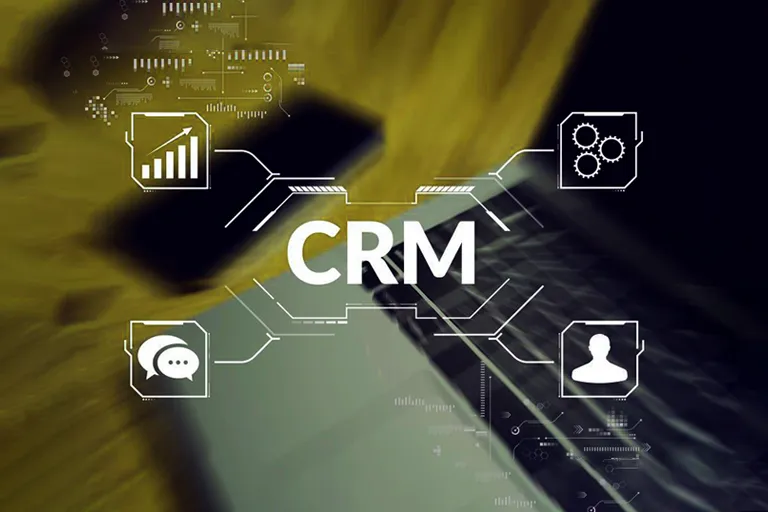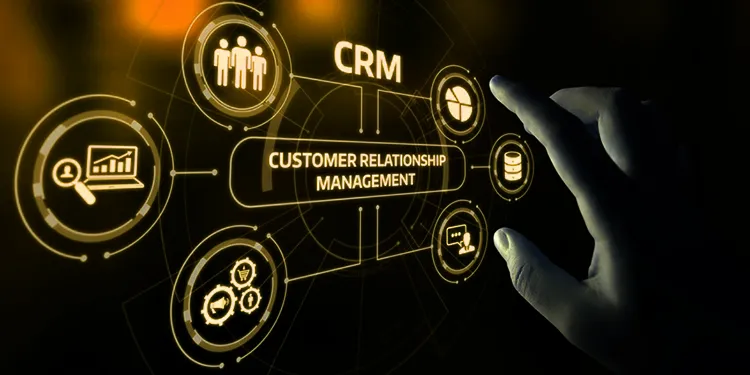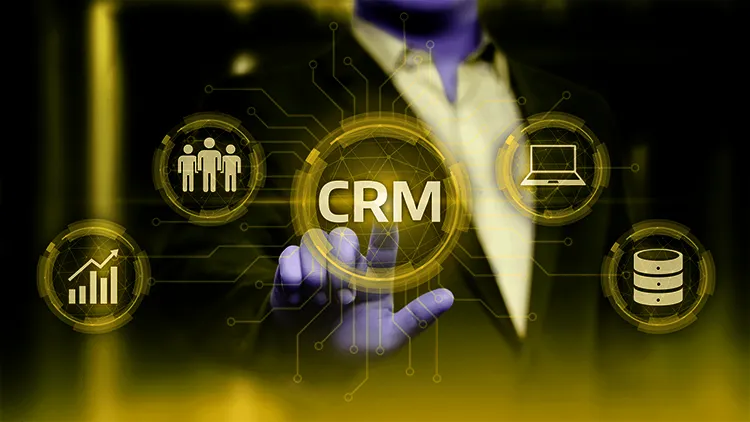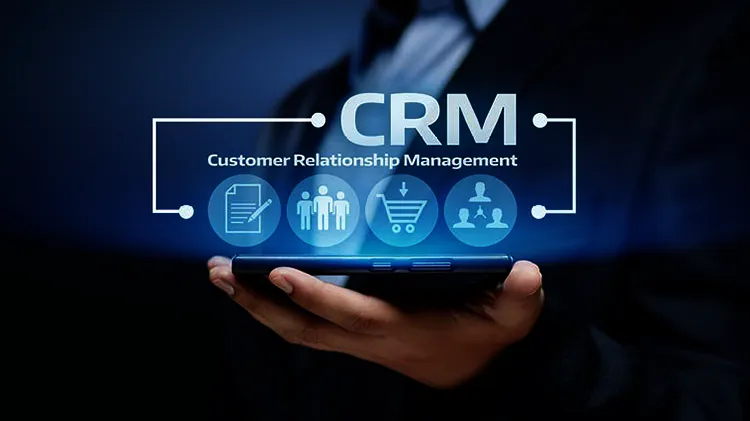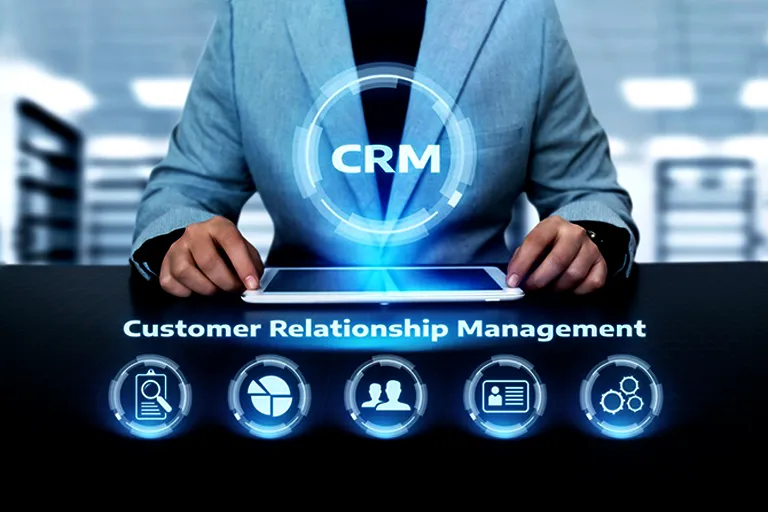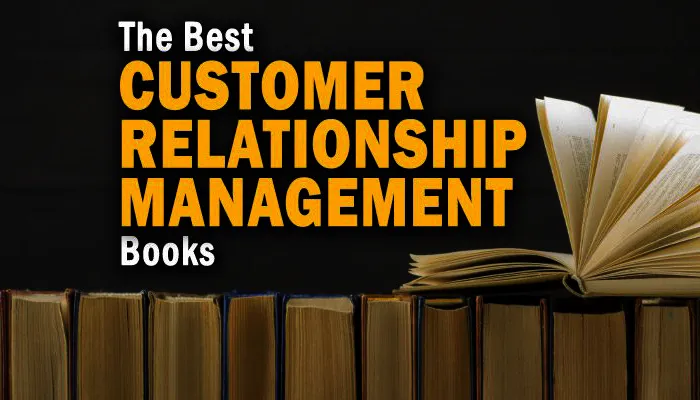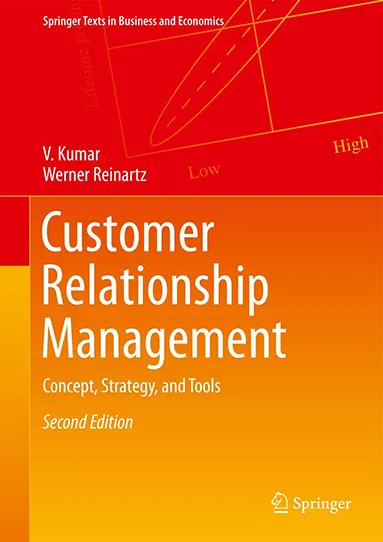The most important thing to remember is that CRM is more than just software and you can’t just buy CRM software and say we now have a CRM .
The term customer relationship management or CRM has entered the field of management and marketing since the early nineties . But there is still no consensus on the definition of customer relationship management and it is not possible to provide a definite and final definition and explanation for CRM.
Even the task of CRM is not clear that when we talk about CRM, we are referring to a software or a system.
To better understand this concept, pay attention to the following examples:
When visiting shopping centers or large stores, you will see a table placed in the corner of the hall and written on it: Customer Affairs. The person standing behind the desk will invite you to register your details in a form and receive a customer club card, or he will take care of your questions and problems. This person will explain to you about the customer club, that you can get discounts with this card, or that you will be informed about the special programs of the shopping center by SMS.
After you receive your 400,000 Toman cake and pastry order from a pastry shop, you will be sent a text message saying that 40,000 Tomans have been added to your credit and you can use it for future purchases.
On the eve of the New Year, you receive a greeting card from a towing company that wishes you a safe and accident-free year. Along with the greeting card, a small booklet has been sent, which describes tips about safe driving during Nowruz trips.
These types of work and efforts are not new. But in recent years, we see more examples of such works than expected. Most of the organizations and businesses that perform such activities consider these tasks as a subset of customer relationship management .
History of customer relationship management
The era of the industrial revolution was the first time when many concepts of modern management and marketing were proposed and popularized, so that time period can be considered as the product-oriented era.
At that time, the general belief was that if the product is good and has quality and meets the customer’s needs, it will find its customer anyway.
Gradually, the number of suppliers increased and for each product you could find multiple examples.
This time, choosing among the available options had become a serious issue for consumers.
Discussions about salesmanship arose at this point in time and gradually grew to the point where it was important for the salesperson to be able to explain to the customer why his product was better than someone else’s.
Gradually, production tools developed and many companies and businesses were able to provide suitable and powerful tools and we entered a stage where anyone who wanted to produce a product just had to buy the production line and the raw materials. buy the appropriate one and establish the related quality processes in the factory.
After this period, the issue of quality came up and after the issue of quality was solved to a good extent, marketers came to the field.
With the advent of marketers and the use of marketing knowledge, we reached a stage where the art of a business was no longer to make a quality product because everyone could do it, but it was important for a business to know the needs and concerns of the customer. And to be able to supply a product that matches the customer’s needs.
At this stage, the industry equation was solved by engineers and designers on the supply side, and now marketing specialists had to try to better understand and manage the demand side.
Brand and branding also emerged in a way during this period, and businesses that wanted to differentiate themselves from others chose branding as a way to differentiate and reduce competitive pressure.
By entering this phase, the relationship-oriented era arose and during the recent decades, it made the story of competition much more complicated, so that it has continued until today.
Now another challenge had arisen and that was increasing the speed of changes in the market.
This challenge was the main reason for emphasizing the creation of a customer base, because conditions in the market were changing rapidly; And it was even possible that the product that was sold today would not be useful at all for some time.
Therefore, in such a situation, it was logical that establishing a good relationship with customers became the main asset of businesses.
Upon entering this stage, customer relationship management became especially important; So that today the discussions of sales skills and strategy and marketing management and branding have become the quotes of various businesses and in all these discussions, benefiting from the benefits of customer relationship management and using CRM software is considered an influential and key factor. .
Currently, the growth of the customer base, if it is accompanied by relationship building, makes a business take its customers not only from one product to another, maybe even from one industry to another, and relying on the good relationship it has with the customer, Increase your strength in facing market uncertainties.
The reason for the importance of customer relationship management
About three decades ago, the term customer relationship management, which we know today as CRM, was almost not used anywhere. But nowadays this term has become very common and we hear it every day.
The reason for the popularity of these systems compared to the past is that in the past, the relationship with the customer, willy-nilly, existed in most businesses. Without the need for special and extra effort.
In other words, the number of customers of each business was small. The variety of products was not the same as today. There were not so many suppliers.
Therefore, regular customers visit specific stores and shops and usually receive the same or similar goods and services.
In such an atmosphere, naturally, the seller got to know the customer over time and a relationship was formed between them. From the supermarket and restaurant on the street to the shoe seller and dry goods store in the city center, they knew their customers and knew their tastes more or less.
This deep and long relationship made customers to be more loyal and not simply go to another seller.
If our fathers wanted to change their hairdresser, they spent weeks mourning what to say if they saw the previous hairdresser on the street.
If our mothers wanted to buy from another meat shop, they had to hide the bag of meat in a thousand ways, so that the neighborhood butcher wouldn’t see it and not be embarrassed.
But nowadays, local purchases are less and the seller doesn’t know the customer, and switching from one seller to another is usually not only difficult and expensive, but even sometimes it can be attractive and sweet.
But we know that today’s business conditions have changed. The number and variety of business customers have increased. It’s not just about big business.
Even local businesses cover a larger geographical area. Access to the telephone, internet, various applications, the possibility of sending products cheaply with postal services and dozens of other factors have all helped to increase the number and variety of customers.
In addition, the variety of customers has increased and for every need, there are so many different options that the customer is tempted to try a new option every time.
The truth is, when there are dozens and hundreds of good restaurants in the city, why should he eat lunch at the same restaurant last week?
There is another point. The variety of products is more than before. A simple dairy brand produces dozens of ice creams and the number of books released each year is the same as the total number of titles that were in a bookstore 40 or 50 years ago. In such a situation, even if a customer buys from a store or a brand for years, it is not easy to remember his preferences and track his taste changes.
In short, it can be said that today more than any other time in the past, creating and maintaining a strong and deep relationship with the customer has become important for businesses. At the same time, this task has never been as difficult as it is today.
This situation has caused the management and marketing experts to compile and present the findings of recent decades in the field of marketing and customer management in the form of a new field called customer relationship management.
Definition of CRM
Customer relationship management is the use of tools, technology and processes to collect and analyze customer data and use this information to improve the customer experience.
CRM is a software that is used with the purpose of sales and marketing automation as well as management of activities related to sales and services within an organization.
In other words, it can be said that CRM or customer relationship management is a macro strategy for all businesses that is used with the aim of optimizing profit and revenue and customer satisfaction. For this reason, in order to achieve these goals, CRM organizes all business activities around different groups of customers and tries to create and develop behaviors in business that ultimately lead to greater customer satisfaction.
Therefore, customer relationship management or CRM is a strategy to better understand the needs and behavior of customers and manage all relationships and interactions of a company with potential customers with the aim of developing and strengthening relationships and of course increasing the profitability of businesses.
The concept of customer relationship
We can talk about the concept of relationship for hours. But for now, we will focus on the five main stages in the formation of a relationship.
Creating a relationship with knowledge
When two people are in a relationship, they know each other and know each other’s interests and preferences.
Communication with the customer also requires the recognition that the business should try to know its customer better every day and to know itself better than before.
Build a relationship with interaction
Until you don’t talk to the other party, until you don’t do something for each other, until there is no interaction between you, a relationship has not been formed.
A person may tell you all the characteristics, preferences, and interests of his friend, and in return, he will tell you about you for hours. Here you have mutual recognition. But there is no relationship. Because you have not interacted with each other.
It is the same in business. In the simplest form, every financial transaction in the customer-business relationship is a type of interaction and is considered a step forward in relationship building. But let’s not forget that interaction is not limited to the transaction and purchase of goods and services.
The exchange of messages between you and the customer, listening to the customer’s words and wishes, talking to the customer, sending a gift to the customer and visiting the store or your website are all examples of interaction.
Creating a relationship with memory
Over time in a relationship, all kinds of interactions, transactions, conflicts and sweet and bitter moments arise and become a part of the shared memory of both parties.
The longer and deeper the relationship, the larger the volume and number of these memories.
The same rule exists in business. Memory in business means documentation. It means recording everything that happened in relation to the customer. It means that you have recorded his purchases, his calls, his complaints, his returned goods or services, and in short, everything between you and him, and you can easily access that information.
Create a relationship with desire
A relationship is not defined only by its past. But the future of the relationship is also important. If you are friends with someone for years, but you don’t think about the future of this friendship anymore, it can be said that there is almost no relationship.
In the business environment, this rule can be interpreted as the desire to repeat the interaction or, specifically, the desire to repeat the purchase.
If the customer has already bought from you and now says that he will make the next purchase from this collection, it means that there is a desire to maintain the relationship.
Or if a customer doesn’t need your product right now, but occasionally visits your site or Instagram account or your store to see what new products you have, you can say they want to maintain the relationship.
Of course, the more common term for propensity in the marketing and customer relationship management literature is loyalty.
Build a relationship with commitment
At its peak, the relationship reaches a point where you cannot see yourself apart from the other person. So much so that if someone talks bad about your friend in his absence, it is hard for you to remain silent and you defend him. While you are interested, talk about your friend as much as you talk about yourself.
In business, the strongest form of relationship is the same. The customer defends the product or brand. He talks about it with his friends and advises others to use that product or brand.
The concept of customer relationship management
In customer relationship management, we look at the customer as more than just paying money and receiving a product.
We want to build a relationship with the customer and maintain and deepen this relationship.
The result of a good relationship is a loyal customer. The result of a great relationship are customers who defend us and introduce us to others.
A good relationship is the result of customer satisfaction. But satisfaction alone is not enough to maintain relationship and loyalty. You may be very satisfied with your purchase, but next time, go to another seller.
A business that wants to have a deep relationship with its customer must know its customer’s needs, preferences and tastes well. Knowing means gathering information and analyzing it carefully.
Businesses, without having a memory of the customer, i.e. recording all the past of the relationship and the events that happened, cannot maintain and strengthen the existing relationship.
Customer relationship management is not only limited to those who have become our customers. Those who are interested in us and follow our activities and products, but have not yet bought from us, have started a relationship with us. A relationship with a customer is not just a financial transaction.
Therefore, it can be said that customer relationship management is, more than anything else, a matter of mentality.
The first question that arises in the discussion of CRM is whether the managers of the organization or business see the customer as just a payment machine? Or do they see him as a friend who is supposed to be with them in a deep and long-term relationship?
If the manager’s view is of the first kind and the relationship is not important to them, there is no customer relationship management in such a group. Even if millions and billions of Tomans have been spent on the deployment of CRM software and hundreds of people work in the organization with job titles such as customer affairs and customer club and customer relationship management and customer voice.
But if the managers’ view is of the second kind, that is, they really want to create a deep and long-term relationship, then we will come to the next important question, and that is whether the infrastructure, processes, systems, software, organizational culture, guidelines, etc. Are they chosen and designed to really maintain and strengthen such a relationship?
The reason for using CRM
Keep in mind that CRM is not about numbers and scale. Rather, the main reason for using CRM is to create and maintain a deep, meaningful and long-term relationship with the customer.
If you don’t have even five or ten more customers and your financial transactions are very limited, you can still think about customer relationship management. But naturally, you don’t need complicated software this time. Maybe it is enough to record the information and tastes and behavior of customers in a small office along with recording the transactions in a software like Excel.
It is important that the customer realizes from the way you speak and the way you deal that you know him and know his background and taste. In very simple words, if a customer comes to you for the fifth time, he should not feel that he is no different from another customer who came to you for the first time and that you have no image or idea of him.
Of course, this is at least a relationship and you should try to go beyond this level.
Types of CRM
Customer relationship management is considered with three completely different approaches, which we will briefly explain in the following three strategic, operational and analytical approaches.
Strategic CRM
Some of those who talk about CRM and communication with customers have a strategic view of this area. This means that their view is not limited to simple tasks such as buying CRM software or, for example, installing a store sales software. Rather, they are looking for the whole business to be organized around the customer.
If in this direction, for example, a CRM unit is formed or some people work as customer relations experts, these are considered minor issues. The main point is to pay attention to the concept of CRM.
It means focusing efforts on customer attraction as well as customer retention through increasing customer satisfaction and using various available tools to increase customer loyalty.
Operational CRM
In the operational view of customer relationship management, every process that is somehow related to the customer is equipped with automatic tools using software systems. Marketing, sales and customer service are among these processes.
This type of view of CRM is not wrong, but if it is not accompanied by a strategic view, it can be said that it is very limited.
However, most automation methods and software equipment can simplify the work of customers and increase customer satisfaction. But the peak of the effectiveness of these activities is when the business is first driven to be customer-oriented and accepts that it wants to move from a product-oriented perspective to a customer-oriented one.
Analytical CRM
In an analytical view of customer relationship management, CRM is a tool for intelligent analysis of customer data and information with strategic or operational goals.
Therefore, if customer information is collected, or if processes are implemented automatically and software, the goal is to collect more information from customers and analyze them to help make better decisions.
If we want to use a more precise term, we should say that CRM in this case is a decision support system. For example, if managers decide to change the price of a product or implement a customer segmentation project, they can refer to the data collected from customers and use common methods in data science to obtain valuable outputs and make better decisions.
Mistakes in customer relationship management
Sometimes businesses consider customer relationship management or CRM as just a subset of the marketing department, like all the other departments and subsets.
Meanwhile, customer relationship management is successful when customer orientation becomes the key philosophy of the organization and the customer relationship unit can interact with other units in a wide and effective way.
Some managers think that customer relationship management is a new tool for the organization’s IT unit. To the extent that they even leave the management of customer relationship management systems and decision making about the capabilities and capabilities of CRM software to their IT specialists.
In the event that customer relationship management is a part of the organization’s strategic processes and should be considered in the management layers.
After a purchase, they take your mobile number and send you promotional SMS for years, this is mobile marketing and not customer relationship management.
The fact that a travel agency sends you information on last-minute tours every week, but you have to enter your passport number in their forms and send a photo of your passport for several trips a year, shows that you are the target of an advertising campaign . Not that a strong customer relationship management system is concerned about your entertainment and travel.
The fact that a business buys the contact number or email of many people from another business or organization and sends a text message or email to all these people and announces its product or service is part of a customer relationship management system. is not. This kind of work is more like a person who puts his number under the wipers of all the cars in a street with the aim of making friends and expects to find a deep and stable relationship in this way.
So, as a result, we can say that in an organization, the philosophy of customer relationship has been established as the operational axis and organizational lifestyle, so that the production unit can improve its products with the help of CRM. Human resource management should make the criterion of evaluating employees, their relationship with customers. The research and development unit should consider the interests and preferences of customers in the decision making and evaluation of new plans, and the different units of the organization should all get to know more about the customers.
Difference between CRM software and CRM system
When we talk about a system, we mean a broad set of activities, processes, and infrastructure that must be deployed in an organization.
But when we talk about a software, our mind goes to one or more programs that must be installed on a number of computers in an organization.
Interestingly, there are both views of CRM among CRM suppliers and customers.
The group whose mentality is closer to information technology and programming and software solutions, consider CRM or customer relationship management to be a set of software that helps to automate marketing, sales and related services.
If you tell this group that you want to implement a customer relationship management system in your company, they will understand that you are going to buy a software or a number of software and install and run them.
But there are other groups who consider the establishment of a customer relationship management system beyond the purchase of customer relationship management software. These people emphasize that CRM is an attitude. An attitude that seeks to create, maintain and develop and deepen the relationship with customers. The fact that new technology software and tools are used in the establishment of CRM is a secondary issue.
Customer relationship management book
Finding and choosing a customer relationship management book to study and learn about CRM is not an easy task.
Numerous software solutions that have been offered in the field of customer relationship management have created a vast competitive market around the world.
Many books and resources and references in this field are actually produced and presented with the direct or indirect support of software solution providers and actually promote a framework that leads to more and better sales of their solutions.
If we skip these types of books, the challenge of choosing a customer relationship management book continues.
Because some books consider CRM to be more of a technical solution and others consider it a kind of philosophy and attitude in business.
For this reason, I recommend you to read two books that have tried to a good extent to maintain scientific neutrality and at the same time maintain the middle line of management process and technology tools.
The first book belongs to Kumar and Reinartz, which was published under the title of Customer Relationship Management .
The second example is the customer relationship management book written by Francis Battle and Stan McLane, where the combination of academic work and presence in the business environment can be felt in different parts of this book.
Download the table of contents of Battle’s customer relationship management book
Download the PDF file of the first chapter of the customer relationship management book
The link to buy Batel’s customer relationship management book

In the end, have you ever interacted with a business and felt that your previous records and connections with that business have been forgotten or not seen? Do you have a suggestion for that business? We are happy to share your comments with us.


